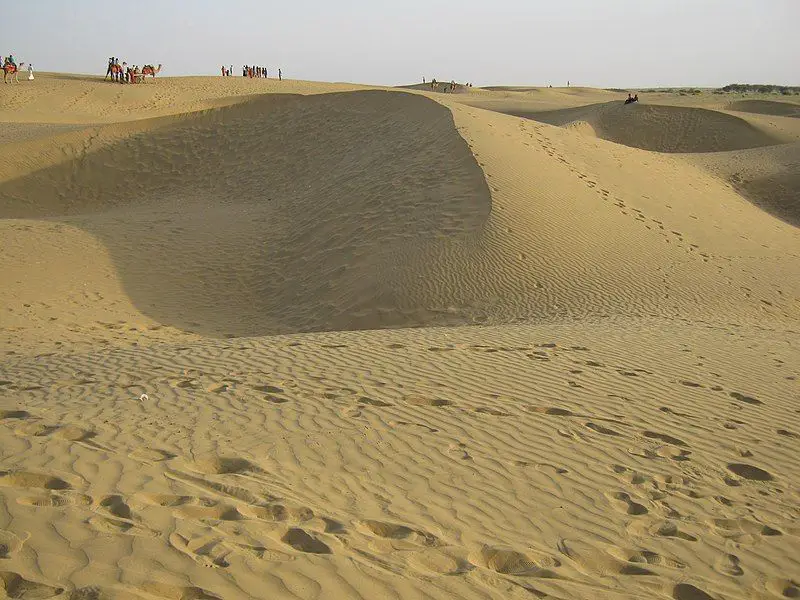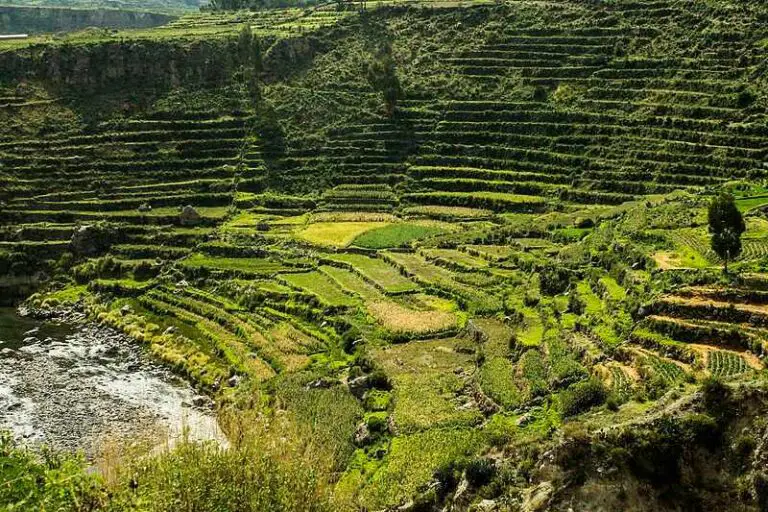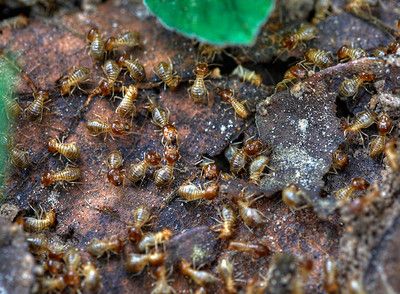5 Abiotic Factors in the Desert and Their Characteristics
Abiotic factors in the desert are; wind, solar radiation, sandy sediments, physicochemical parameters, and precipitation.
This article discusses abiotic factors in the desert and their characteristics, as follows;
1). Wind (as one of the Abiotic Factors in the Desert)
Desert wind refers to powerful air currents that propagate across arid landscapes under the influence of solar-thermal, gravitational, oceanic and geomagnetic forces.
Other terms that may be used in reference to desert wind include; desert windstorm and arid air currents.
Desert wind is an abiotic factor because it comprises of the physical dynamics of inorganic gases in the atmosphere.
The importance of wind in the desert is immense, and can be observed in its contribution to weathering and erosion, landscape modification, soil formation, organic adaptation, and the trend of desert climatic conditions.
Desert winds form due to convective cycles of air currents that are set-up by intense heating and vertical variations in temperature of air masses.
Intense heating in the daytime causes warm air (which has relatively-low density) to rise upward and be replaced by cooler air masses from the surrounding environs. This is what establishes the convective dynamic that moves air masses to form the strong currents called wind.
Much of desert wind comes from the hinterland, especially from aquatic ecosystems like oceans, whose tidal and wave energy-influence also sets up a convective trend of coastal air-recycling that interacts with that of the desert.
Characteristics of desert include high intensity and low humidity.
The velocity of desert wind can be up to 60 km per hour [1] in some areas. This can be partly attributed to the lack of dense vegetation (such as that which is found in forests) to serve as a physical barrier to wind flow.
Low humidity implies that desert winds are dry, and proves that air currents from the hinterland lose most of their moisture before reaching the desert. The dryness of desert winds and their intensity are hugely responsible for the consistency of arid conditions in deserts, as they facilitate rapid evaporation of moisture in sediments.
Types of desert wind include; Sirocco, Santa Anna and Haboob winds [6]. These differ in their geographic coverage, trend, and even slightly in their environmental impacts.
Desert wind is a crucial abiotic factor that plays a key role in erosion and in the formation of distinctive features typical of desert landscapes, like dunes. It is the primary cause of air pollution by dust particles in arid areas, and contributes to the overall harshness of its environment.
2). Solar Radiation
Solar radiation is generally intense in the desert.
It is an important abiotic factor due to its role in supplying renewable energy that is used by the entire desert-energy pyramid.
As a spectrum of electromagnetic waves, solar radiation comprises of infrared, ultraviolet and visible light-rays, among others.
There are various reasons why solar radiation has high-intensity and abundance in deserts. One of these is the geographic location of most deserts, which falls few degrees (25-35% on average) North and South of the equator.
This location ensures that solar radiation falls directly on arid zones with minimal atmospheric deflection and attenuation, while excluding such zones from high precipitation that is typical of core equatorial regions.
Another reason for intense solar radiation in the desert is low humidity and precipitation, which reduce obstruction of the path of travel, of electromagnetic rays from the Sun, by water vapor and clouds.
With minimal seasonal fluctuations, most deserts in the world receive significant amount of solar radiation all year-round.
Intense solar radiation goes along with thermal energy, which explains why the desert's climate is usually hotter than adjacent regions. After sunset, temperature tends to fall rapidly in the desert [7], because the absence of humidity reduces the ability of air and soil to retain heat.
This trend of extremely-high daytime temperature and extremely-low nighttime temperature has played a role in the adaptation of desert animals and plants, including distinctive physiological and behavioral attributes that enable them survive.
Lastly, intense solar radiation in the desert, along with its barren, remote nature, makes it an ideal location for solar energy projects [5]. Several of such projects have been launched successfully on various scales, including the installation of solar panels, concentrated solar systems and power plants.

3). Sandy Sediments (as one of the Abiotic Factors in the Desert)
Sediments in the desert are predominantly composed of sand particles, which range from 0.0625 to 2.0 millimeters in diameter [2].
These particles occurs are loose, dry earth material produced from multiple phases of intense physical weathering.
Sandy sediments are a typical and defining feature of the desert, and may occur in abundance, so that they constitute what is referred to as 'sand seas'.
Some arid regions like the Great Sandy Desert of Australia [3], are named in reference to the presence of such sediments.
The most dominant mineral in sandy sediments is quartz, and this is because of its high-resistance to weathering. Desert soils receive their characteristic light-coloration from quartz grains.
Size differences among the particles that make up desert sediments are small, meaning that these sediments are roughly uniform in size. An alternative way to describe this is by saying that desert sediments are 'well-sorted'.
The origin of these materials is traceable to aeolian processes involving wind, which is the primary agent of erosion, weathering and transportation in arid regions.
While there are microbial and non-microbial organisms in desert sediments, their populations are small compared to those in grasslands, tundras and forests, mainly because of the extreme-dryness of the sediments.
Desert sediments are also less-efficient as carbon sinks that sequester and retain carbon, than soils in more-humid biomes.
Lastly, the loose and dry attributes of sandy sediments in the desert play a role in the formation of arid geographic features like linear and barchan dunes.

4). Physicochemical Parameters
Physicochemical parameters are abiotic elements that control the physical and chemical conditions of a given environment.
The physicochemical parameters of deserts control their climatic conditions, and exert influence over biotic components like animals, plants, and biological processes.
Physicochemical parameters influence the Net Primary Productivity (NPP) of deserts; which is a measure of the amount of biomass produced through photosynthesis, by primary producers [4].
Other abiotic factors that affect NPP in the desert are; sediment characteristics and wind.
Examples of desert physicochemical parameters are; salinity, temperature, light-intensity, pH, nutrient availability, and humidity.
Because of their influential role, it is generally needful to include physicochemical parameters in studies of desert conditions.
5). Precipitation (as one of the Abiotic Factors in the Desert)
Low precipitation is a typical characteristic of deserts.
Deserts are generally defined as having less than 250 millimeters of rainfall annually.
Factors responsible for the level of precipitation in the desert include; distance from intra-continental water bodies, obstruction of moist air currents by mountain ranges, and convective circulation of wind.
Conclusion
Abiotic factors in the desert are;
1. Wind
2. Solar Radiation
3. Sandy Sediments
4. Physicochemical Parameters
5. Precipitation
References
1). Ahmed, S.; Compton, S. G.; Butlin, R. K.; Gilmartin, P. M. (2009). "Wind-borne insects mediate directional pollen transfer between desert fig trees 160 kilometers apart." Proc Natl Acad Sci U S A. 2009 Dec 1;106(48):20342-7. https://doi.org/10.1073/pnas.0902213106. (Accessed 23 May 2023).
2). Das, G. K. (2015). "Sediment grain size." Available at: https://doi.org/10.1007/978-94-017-8801-4_148. (Accessed 23 May 2023).
3). Etten, E. J. (2020). "The Gibson, Great Sandy, and Little Sandy Deserts of Australia." Encyclopedia of the World's Biomes (pp.152-162). Available at: https://doi.org/10.1016/B978-0-12-409548-9.11967-0. (Accessed 23 May 2023).
4). Huston, M. A.; Wolverton, S. (2009). "The global distribution of net primary production: Resolving the paradox." Ecological Monographs 79(3):343-377. Available at: https://doi.org/10.1890/08-0588.1. (Accessed 23 May 2023).
5). Komoto, K.; Ehara, T.; Xu, H.; Lv, F.; Wang, S.; Sinha, P.; Cunow, E.; Wade, A.; Faiman, D.; Araki, K.; Perez, M. J.; Megherbi, K.; Brever, C.; Bogdanov, D. (2015). "Energy from the Desert: Very Large Scale PV Power Plants for Shifting to Renewable Energy Future." EIA. Available at: https://www.researchgate.net/publication/273886472_Energy_from_the_Desert_Very_Large_Scale_PV_Power_Plants_for_Shifting_to_Renewable_Energy_Future. (Accessed 23 May 2023).
6). Miller, S. D.; Kuciauskas, A. P.; Liu, M.; Ji, Q.; Reid, J. S.; Breed, D.; Walker, A. L.; Al Mandoos, A. (2008). "Haboob dust storms of the southern Arabian Peninsula." Journal of Geophysical Research Atmospheres 113(D1). Available at: https://doi.org/10.1029/2007JD008550. (Accessed 23 May 2023).
7). Rewald, B.; Amir, F.; Shelef, O.; Hill, A.; Degu, A.; Friediung, A.; Rachmilevitch, S. (2012). "Hot desert environments." Environments, organisms and strategies for survival (pp.196-218). Available at: https://doi.org/10.1079/9781845938147.0196. (Accessed 23 May 2023).





